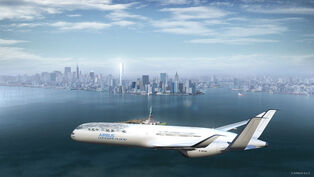
Airbus Passenger Plane in the year 2050.
The transportation of passengers on airplanes will advance in the year 2065. Flight time from New York City to Las Vegas time in half. Some plane has advanced to three floors and doubled in crew(about 30 crew members on a regular flight.
Avation History[]
The history of aviation has extended over more than two thousand years from the earliest kites and attempts at tower jumping to supersonic, and hypersonic flight by powered, heavier-than-air jets. Kite flying in China dates back to several hundred years BC and is thought to be the earliest example of man-made flight. Some kites were capable of carrying a man into the air. The ancient Chinese also flew small hot-air lanterns and bamboo-copter toys with spinning rotors. Leonardo da Vinci's 15th-century dream of flight found expression in several rational but unscientific designs, though he did not attempt to construct any of them. Efforts to analyze the atmosphere from the 17th to 19th centuries led to the discovery of gases such as hydrogen, which in turn led to the invention of hydrogen balloons. Various theories in mechanics by physicists during the same period of time, notably fluid dynamics and Newton's laws of motion, led to the foundation of modern aerodynamics. Tethered balloons filled with hot air were used in the first half of the 19th century and saw considerable action in several mid-century wars, most notably the American Civil War, where balloons provided observation during the Battle of Petersburg. The term aviation, noun of action from stem of Latin avis "bird" was coined in 1863 by French aviation pioneer Guillaume Joseph Gabriel de La Landelle (1812-1886) in "Aviation ou Navigation aérienne". Experiments with gliders provided the groundwork for heavier-than-air craft, and by the early 20th-century advances in engine technology and aerodynamics made controlled, powered flight possible for the first time.



